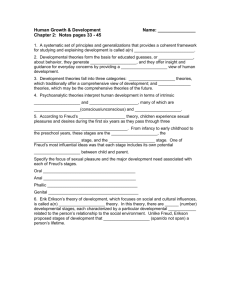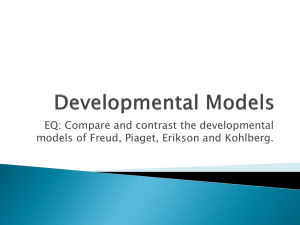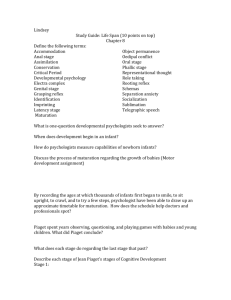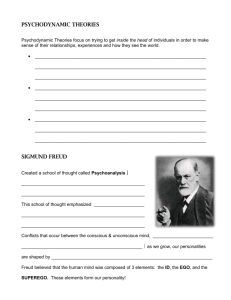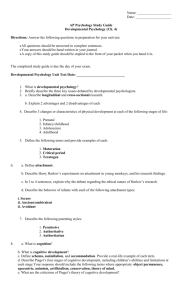Developmental Psychology
advertisement
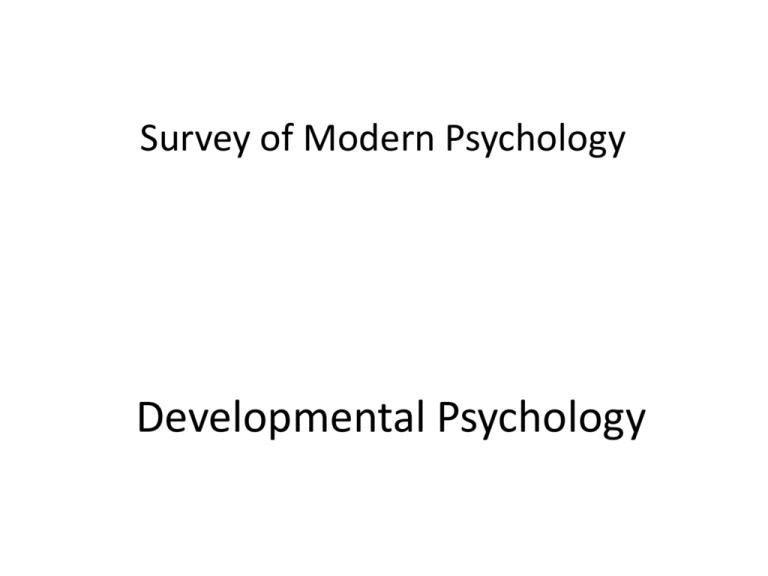
Survey of Modern Psychology Developmental Psychology Views on Infant Learning • Nativist – Important aspects of perception and other cognitive processes are innate – We have built in knowledge of what sensory inputs mean • Empiricist – All knowledge comes from experiences and our senses – We relate sensory inputs to each other to determine what they mean Infants Upon birth, humans can: • Discriminate between different tones, pitches, and loudness – It’s suggested that newborns show a preference for their mother’s voice • See within a range of about four feet – Discriminate brightness, color, and follow a moving stimulus with their eyes Infants • Grasping reflex: – Infants close their fists tightly around objects placed in their palms – If the object is lifted, an infant can hang on and support his or her weight for about a minute • Rooting reflex – When an infant’s cheek is touched, their head turns toward the stimulus while opening their mouth until the stimulus is in their mouth – This triggers a sucking reflex These are considered reflexes (automatic responses) but are replaced by directed responses (voluntary) with development Babies are cute for an evolutionary advantage We instinctively find a rounded face, large eyes, and other baby features “cute;” this encourages us to want to protect and care for a baby even if it’s not ours. The evolution of Mickey Mouse capitalizes on this factor. Motor Development Linguistic Development Age Linguistic Achievement 3 months Cooing 4 months Babbling 10 months First word 18 months About 20 words One word utterances About 250 words Two word utterances About 500 words Three plus word utterances 24 months 30 months Important Times in Development In general, a child’s reaction to their environment depends on their age (and amount of knowledge) • Critical Periods – Times in development when certain events have an enormous impact – The same events have less impact if they occur earlier or later – If they happen too late, certain milestones will not be reached and a certain path of development is set Important Times in Development • Sensitive Periods – Similar to the idea of critical periods, but with less rigid boundaries – During this time, the baby is particularly sensitive to a particular influence • For example, attachment to parents is more easily formed at an early age Practice • Some maturation will happen regardless of outside influences (due to genetics) – Some milestones cannot be reached until a certain age; the infant’s brain and muscle tone must reach sufficient development • Some development depends on experience as well – For example, animals raised in complete darkness do not develop all structures of the visual system and therefore cannot see properly later on if exposed to light Developmental Theorists • Piaget • Freud • Mahler • Erikson • Kohlberg There is question about how accurate any of these theorists are, but their contributions are important in a historical sense Piaget Piaget is considered the first theorist to say that children were not miniature adults, but were different and went through a series of psychological changes on the way to adulthood Piaget Believed that human development and behavior come from consistent and reliable patterns of interaction with the environment called schemas • Schemas are goal oriented strategies that people use to explore and learn about the world and their environment Piaget Said that children learn through: • Adaptation: the exchange between an individual and his or her environment – Assimilation • The incorporation of one’s environment into an existing schema – Accommodation • The adaptation or modification of an existing schema to the characteristics of a new object Ex. a “grabbing an object” schema Piaget’s Stages 1. 2. 3. 4. Sensory-Motor: birth to 2 years Preoperational: 2 – 7 years Concrete Operational: 7 – 11 Formal Operational: 11-15 Piaget: Sensory-Motor Stage Birth – 2 years • The infant uses his or her senses and motor functions to understand the world • Infants do not differentiate between “me” and “not me” and lack object permanence – Object permanence: the understanding that an object exists outside of our immediate experience – Infants do not understand that a rattle continues to exist even if he or she is not holding it Piaget: Sensory-Motor Stage Birth – 2 years A not B effect • When a 9 month old sees an experimenter hide a toy under a blanket on their right (A), the child will remove the blanket to retrieve the toy • If the experimenter then hides the toy under a blanket on their left (B) (while the baby is watching) the baby will continue to search for the toy on the right • The baby interprets location A as being part of the toy’s identity Piaget: Sensory-Motor Stage Birth – 2 years • In the later 6 months of this stage, babies begin to form representational thoughts and can keep an object or event in their memory • For example, understanding that the toy exists even when it’s not seen is a mental representation of that toy – At this age, a child will become angry or frustrated if a toy is not where he or she left it Piaget Preoperational Stage 2 – 7 Years • Children gain a well organized mental representation of the world • Develop a more sophisticated set of schemas called “operations” – Operations allow an internal manipulation of ideas according to a stable set of rules • This begins at about 7 years of age • Use of symbols, language, and speech • Understanding of past, present, and future Piaget Preoperational Stage 2 – 7 Years • Children remain egocentric – do not understand that other people have different experiences from themselves – In a study, children 4 – 7 were given a 3-D model of a scene – While the child viewed the scene from one location, a teddy bear was placed in different locations around the model – When asked what the teddy bear would see, children consistently said that the bear saw the same thing they did Egocentrism http://www.youtube.com/watch?v=OinqFgsIbh0 Piaget Preoperational Stage 2 – 7 Years Failure of Conservation • Equal sized glasses A and B were put side by side and filled with the same amount of colored liquid – 4 year olds can easily say that the amounts are equal • A new glass C is added that’s taller and narrower than the original glasses, and the liquid is poured from A to C – When asked if there is more liquid in glass B or C, children say C because the level of higher Children do not yet understand that the amount of liquid is constant, even though it is being acted upon Conservation of Number A young child will reply that there are more objects when they are spread further apart from each other Piaget Concrete Operational 7 – 11 Years • Children understand conservation and that changes to one aspect of a situation by be compensated for by changes to a different aspect • Children can understand concrete operations, but lack the ability to think abstractly – Ex. 8 or 9 year olds can understand that 4 is an even number and 4 + 1 is an odd number; 6 is even, 6 + 1 is odd – Tend to not see the pattern that adding 1 to any even number yields an odd number Piaget Formal Operational Stage 11 – 15 Years • Children expand from concrete thinking to abstract or hypothetical thinking • Can consider hypothetical possibilities Problems with Piaget Object Permanence and Occlusion • 4 month olds were an image of a rod that moved back and forth behind an occluding object A Object Permanence and Occlusion • After becoming habituated to the original display, babies were shown a non-occluded image – B with an unbroken moving rod – C with a broken rod B C Object Permanence and Occlusion Infants spent more time looking at C than at B This suggests that they expected the rod to be one solid piece, even though they could not see the entire rod Understanding of Numbers • 6 month olds were shown two panels simultaneously with pictures of two or three simple objects • A drum was sounded over a loudspeaker with booms in sets of two or sets of three • When hearing “boom boom,” babies looked at the panel with two items • When hearing “boom boom boom,” babies looked at the panel with three items This implies that the babies connected the idea of “two” or “three” between sound and visual stimuli Conservation of Number • Children generally do demonstrate understand that adding an item increases the number of items in a set and that adding one and subtracting one leave the total unchanged • Lack of conservation of number implies that a child confuses, for example, the length of a row with the number of objects in a row Conservation of Number • In Piaget’s research, children were asked the same questions twice very quickly, one after another • It’s theorized that children may have believed that the experimenter did not like the child’s first answer (“they’re the same”) and therefore changed it when asked again Egocentrism • In a study, 2 ½ - 3 year olds were given a photograph and asked to show it to their mother, who was sitting opposite the child • Children turned the photo so that it faced the mother, implying that they realized that she had a different viewpoint than they did Egocentrism and Beliefs There is evidence that a developmental change occurs between 3 and 4 ½ years of age • In “false-belief tests” a child and teddy bear are seated in front of two boxes, one red and one green • The child and teddy bear watch the experimenter put candy in the red box, and the experimenter shows both that the green box is empty • The bear is taken out of the room, and the child watches the experimenter switch the candy to the green box Egocentrism and Beliefs • The teddy bear is brought back into the room, and the experimenter asks the child where the teddy bear will look for the candy • At age three, children will say the green box “because that’s where it is” • By age 4 ½ children will say that the bear will look in the red box because that’s where the bear thinks the candy is This indicates knowledge that others have a different experience from our own, and understanding that others may have a false belief Conservation http://video.google.com/videoplay?docid=-4958684466064517394# Freud • Believed that people go through discrete sequential psychosexual stages of development • Moving from one state to the next was dependent upon resolving “conflicts” in the previous stage – Unsuccessful resolution would result in being stuck in that phase (fixation) and the person would hold on to maladaptive behaviors from that phase • It would also lead to anxiety and mental illness • Thought that people are driven by a desire for pleasure, and at different ages different points of the body were the focus for pleasure Freud Stage 1: The Oral Stage 0 – 1 ½ Years • Pleasure is derived from stimulation of the mouth (ex. sucking) • Babies get pleasure from feeding or nursing, but also learn about the world by putting objects in their mouths • The major difficulty in this phase is weaning, when a baby has less close contact with his or her mother Freud Stage 1: The Oral Stage 0 – 1 ½ Years Unsuccessful resolution of the oral stage would result in: • Passivity • Immaturity • Manipulative personality Freud Stage 2: Anal Stage 1 ½ - 3 Years • The focus of attention becomes the child’s anus • Physiologically, babies begin to gain control over their bowels at this age and toilet training starts – The more immediately pleasurable solution for a child is to “go” wherever and whenever • Ideally, according to Freud, toilet training is done gradually so the child slowly learns why it’s important Freud Stage 2: Anal Stage 1 ½ - 3 Years • Conflict in the anal stage happens if parents are either too strict or not strict enough in toilet training – Being too strict would result in an obsession with organization or excessive neatness • “Anal – Retentive” – Not being strict enough would result in recklessness, carelessness, defiance, and disorganization Freud Stage 3: Phallic Stage 3- 6 Years • Attention shifts to the genitals – This is not in a sexual fashion • Children discover that they have genitalia, and that boys and girls are different • Children become more curious about their own, and others’, bodies Freud Stage 3: Phallic Stage 3- 6 Years • The main conflict in the phallic stage is the Oedipus Complex – Boys want to marry their mothers (or rather, to have possession of the mother because she fulfills needs) – As a result, the boy wants to kill his father because the father is his obstacle to his mother; however, the father also provides for the child and is bigger and stronger, so the boy knows that he cannot actually kill his father • The boy develops “castration anxiety” fear that the father will punish the boy Freud Stage 3: Phallic Stage 3- 6 Years • For girls, this is more complicated – Freud said that girls realize that not only is her father an obstacle, but she does not have a penis – Girls develop “penis envy” because of their lack of power • Another proposed alternative to the Oedipus Complex for girls was the Electra Complex Freud Stage 3: Phallic Stage 3- 6 Years • Ideally, the stage is resolved by the child identifying with their same-sex parent (a boy identifies with his father, a girl identifies with her mother) – Identifying with a parent helps the child internalize morals • For girls, lack of resolution causes striving for superiority over men or being overly seductive, flirtatious, or submissive with low self esteem • For boys, lack of resolution causes excessive ambition and vanity • Lack of identifying with one’s parent would lead to recklessness or immorality Freud Stage 4: Latency Stage 6-12 Years • The child’s focus on their genitals and sexuality develops into more socially acceptable behaviors • Pleasure is derived from the mind and activities (school, socializing, etc.) Freud Stage 5: Genital Stage 12 - adult • (puberty through adulthood) • The person learns to accept his or her genitals and begins to experience mature sexual feelings • The major tasks are full separation from one’s parents and resolving conflicts from the previous stages • The primary goal is accepting adult responsibilities Freud - Criticisms • Freud’s developmental theories were heavily focused on men and the male experience – For example, “penis envy” seemed to better reflect women envying the power and social status that men had, not the penis specifically Freud - Criticisms Parents, especially the mother, are blamed for pathology Margaret Mahler Object Relations Theory • Focuses on the relationship between a mother (or caregiver) and the infant and the effect of this relationship on the infant’s development of a sense of self • Believes that individuals are born with a drive to build interpersonal relationships • The individual’s sense of self and others affects all subsequent interpersonal relationships Margaret Mahler In Object Relations, the main developmental task is differentiating between the self and others The three main stages of development are: 1. Autistic stage: newborn – 1 month 2. Symbiotic stage: 1 – 5 months 3. Separation-Individuation stage: 5 – 24 months “Object” refers not only to literal objects, but to other people Margaret Mahler Autistic Stage newborn – 1 month • The infant is focused entirely on him or herself • Mostly unresponsive to external stimuli • Does not perceive others as separate beings Margaret Mahler Symbiotic Stage 1 – 5 months • The infant begins to perceive the mother/caregiver as a “need-satisfying object” • The infant feels unity with the mother, but begins to understand that the mother is a separate being Margaret Mahler Separation – Individuation Stage The Separation-Individuation Stage is made up of four sub-stages 1. Differentiation: 5 – 9 months 2. Practicing: 9 – 14 months 3. Rapprochement: 14 – 24 months 4. Object Constancy: after 24 months Margaret Mahler Separation – Individuation Stage • Differentiation Sub-Stage: 5 – 9 months – The infant’s attention shifts from being inwardly focused to outwardly focused – The infant begins to separate from the caretaker (for example, learning to crawl) Margaret Mahler Separation – Individuation Stage • Practicing Sub-Stage: 9 – 14 months – The infant continues to separate from the caretaker – More autonomous functioning – The infant becomes more independently mobile and more active • Ex. walking, playing, etc. Margaret Mahler Separation – Individuation Stage • Rapprochement Sub-Stage: 14 – 24 months – The baby begins to want to act independently – The baby moves away from his or her mother/caregiver, but regularly comes back to make sure that the caregiver is still there Margaret Mahler Separation – Individuation Stage • Object Constancy Sub-Stage: after 24 months – The baby has an internalized mental representation of his or her caregiver and understands that the caregiver continues to exist even when they are not together Mahler and Object Relations A transitional object is an object that the individual can mentally associate with a specific person when that person is not physically present Ex. a “security blanket” or for adults a piece of jewelry/heirloom Erikson • Psychosocial Theory – Emphasizes individual’s ability to change and shape their personalities – Believes that childhood is an important time in development, but that development continues throughout the lifespan – People have the ability to adapt to and change their environments – Considers the importance of the individual’s own psychological system, but also their biology and social systems Erikson • Each stage of development focuses on a particular area of growth, builds on the previous stages, and paves the way for future stages • Each stage has a psychosocial crisis which must be resolved – The crises are marked by a conflict between two opposing personality traits – Healthy development requires a balance between the two • Crisis resolution depends on the individual and his or her social environment Erikson Trust v. Mistrust Autonomy v. Shame and Doubt Initiative v. Guilt Industry v. Inferiority Identify v. Role Confusion Intimacy v. Isolation Generativity v. Stagnation Ego Integrity v. Despair Birth to 1 year 2 – 3 years 4 – 5 years 6 – 11 years 12 – 18 years (adolescence) 20 – 35 years 35 – 50 years 50 years and up Erikson Trust v. Mistrust: birth – 1 year • The infant develops a sense of trust in others through being nurtured and loved • If an infant is not nurtured and loved, he or she will experience a high level of mistrust – This causes the child to be withdrawn later in life Erikson Autonomy v. Shame and Doubt: 2 – 3 years • The child begins to develop skills that allow him or her to be autonomous – i.e., motor and verbal skills • The child becomes more confident and in control • If a child is not provided with what he or she needs socially (ex. nurturance) he or she will feel ashamed and less confident Erikson Initiative v. Guilt: 4 – 5 years • The child becomes curious and moves around into new spaces to explore • The child learns to play with others • A child who is not allowed to take initiative will feel guilty and fearful Erikson Industry v. Inferiority: 6 – 11 years • A child develops a need to do things well, work, and to provide in the future • School and peers are important in assisting the child in his or her mastery over tasks • If a child fails to achieve a sense of mastery, he or she will feel inferior and incompetent Erikson Identity v. Role Confusion: 12 – 18 years • An adolescent begins to create his or her own identity and integrate the various components of him or herself into a whole person • An adolescent who is unable to integrate will experience role confusion Erikson Intimacy v. Isolation: 20 – 35 years • The individual learns to build reciprocal relationships with others socially, sexually, and occupationally • Individuals who do not build these relationships will feel isolated Erikson Generativity v. Stagnation: 35 – 50 years • The individual develops the capacity to care and nurture • An individual who fails at this stage will focus only on caring for him or herself Erikson Ego Integrity v. Despair: 50+ years • The individual learns to accept his or her own life achievements and those of significant others • If the individual fails at this, he or she will experience despair Kohlberg • Believed that at birth people lack all morals, ethics, and honesty; moral development is leaned from the individual’s family • Three levels of moral development, each consisting of two stages Kohlberg • Pre-Conventional Level: birth – 9 years • Conventional Level: 9 – 15 years • Post-Conventional Level: 15 - adult Kohlberg Pre-Conventional Level Birth – 9 Years • Stage 1 – Begins at school age – In this stage we behave according to social norms to avoid punishment • Stage 2 – The individual acts according to his or her own best interest Kohlberg Conventional Level 9 – 15 Years • Stage 3 – The individual behaves to gain the approval of others • Stage 4 – The individual behaves in accordance with laws and rules Kohlberg Post-Conventional 15 - Adult • Stage 5 – The individual begins to gain a genuine interest in others and to understand social mutuality • Stage 6 – The individual develops autonomous morality based on individual conscience • Kohlberg believed that no one actually reaches level 6 Kohlberg’s Theory of Moral Development Level Stage Social Orientation PreConventional 1 Obedience: Avoid punishment 2 Personal reward Conventional 3 Good boy/good girl Gain approval and avoid disapproval 4 Law and order Conformity with rules 5 Social contract 6 Universal ethical PostConventional Summary of Developmental Theorists • Opinions differ over whether stages must happen sequentially and whether we move from one stage to another abruptly or gradually • Opinions differ over what happens if stages are not completed in the ideal fashion • It’s not truly possible to “prove” any one of the theories completely true or false – They largely give suggestions to guide research and interpret behavior Attachment • Old theory said that infants are attached to their mothers because the mother satisfies basic physical needs – Food, warmth, physical protection, relief from pain – This was known as the “cupboard theory” Attachment • John Bowlby and others said that there had to be more to attachment than fulfillment of basic needs – For example, babies show interest in strangers who do not provide food • The new belief was that infants are born with social needs and therefore seek contact • The mother therefore fulfills needs and provides interaction, safety and a feeling of comfort Attachment • Harlow conducted a study using newborn rhesus monkeys raised without their mothers • Each monkey lived in a cage with two figures •A “wire mother” that had a nipple to dispense milk •A “terry-cloth mother” that did not provide food but was cuddly Harlow • The monkeys spent significantly more time with the terry-cloth mother • Harlow presented the monkeys with a mechanical toy that made loud noises; the monkeys rushed to the terry cloth mother and clung to “her,” suggesting that they were seeking comfort Harlow • Overall, Harlow concluded that babies are attached to their mothers because the mother provides comfort, not simply as a source of things Attachment • In further studies, Harlow isolated monkeys completely (provided food, but no terry-cloth mother figure) • Three months of isolation had little effect, but longer periods led to major disturbances – The monkeys huddled in a corner of the cage and rocked back and forth – When exposed to normal monkeys, they did not engage in play and instead withdrew, rocked, and bit themselves Attachment – Harlow continued • Monkeys raised in isolation later on could not engage in normal interactions with other monkeys and tended to become violent • If they had babies, they showed no ability to love or care for their offspring – In some cases, the monkeys actually abused their babies Attachment What about humans? • Infants raised in relative isolation in orphanages showed major developmental impairments – Some were desperate for love and attention – Others were apathetic to people – they did not approach or seek comfort from other people • Other studies of people who were raised in deprived orphanage environments show intellectual deficits, particularly in language and abstract thinking; heightened physical aggression; delinquency; indifference to others Repairing the Damage • Monkeys raised in isolation were later placed with monkeys younger than themselves – The younger monkeys sought contact, but would not be physically aggressive • The older monkeys eventually adapted and were able to play and normally interact • While monkeys who were raised in isolation showed difficulty mothering a first child, they reacted normally to second born babies Repairing the Damage • Similar results have been found with humans – People who were taken out of the orphanages eventually caught up with their peers, while those who stayed in orphanages longer did not Attachment Styles There are two aspects to attachment: 1. Being with the caregiver brings contentment 2. Being away from the caregiver evokes distress Initially, infants cannot always differentiate their own mother from other adults. By 6 – 8 months, the infant knows who his or her mother is and becomes upset when they are separated Ainsworth and the Strange Situation Mary Ainsworth developed the following method of studying a baby’s attachment (generally used with 1 year olds) to his or her mother: • A child is brought to an unfamiliar playroom and is given the chance to explore and play with the mother present • After some time, a stranger (the experimenter) comes in, speaks to the mother, and approaches the child Ainsworth and the Strange Situation • The mother leaves the room briefly, leaving the child alone with the stranger • After a few minutes, the mother returns and the stranger leaves – (In some variations, the mother leaves twice. The second time the stranger leaves as well, leaving the child alone in the room) The focus is primarily on how the baby responds to the mother’s returning, with some attention paid to the baby’s behavior when the mother is absent. Babies are said to have one of the following “attachment styles” Attachment Styles • Securely attached – The child explores the room while the mother is there and may interact with the stranger – Shows some distress when the mother leaves – Is very happy and quickly consoled when the mother returns • People who are securely attached as children tend to be better adjusted socially as adults and have better self esteem Attachment Styles • Anxious-Ambivalent Insecure Attachment – Does not explore/explores very little when the mother is present – Becomes upset and panicky when the mother leaves – Acts ambivalent during the reunion • E.g., runs to the mother to be picked up, but immediately wants to be put down • Might push the mother away • It is believed that these pairs interact on the mother’s terms only • As adults, they are more likely to have difficulties in relationships and worry that their partner does not love him or her Attachment Styles • Anxious-Avoidant Insecure Attachment – The child is distant and aloof from the beginning of the interaction – Shows little distress when the mother leaves the room – Ignores the mother when she comes back • It is believed that the mother is generally disengaged from the child and often does not meet his or her needs. The child comes to feel that his or her actions have little to no impact on the mother • As adults they are more likely to have problems with intimacy and invest little in social or emotional relationships Attachment Styles • Disorganized Attachment (this was added later) – The child cries during the separation, but is not comforted by the mother when she returns – The child may avoid her, curl up on the floor, or show stereotyped behaviors (i.e., rocking, hitting oneself) – This is more common if the mother experienced a loss shortly before or after the child’s birth and was severely depressed – The child is likely to act like a caretaker for his or her mother Attachment Styles • http://www.youtube.com/watch?v=QTsewNr HUHU Summary of Attachment In America, secure attachment is considered ideal and about 65% of 1 year olds are securely attached. Which attachment style is considered healthiest depends on cultural variables and values Summary of Attachment • It is unclear whether the mother causes the child’s behavior entirely, or if it is a reciprocal relationship • If a child naturally engages less, the mother may adapt and learn to engage less with her child • More recent research has shown that babies exhibit the same attachment styles with fathers

